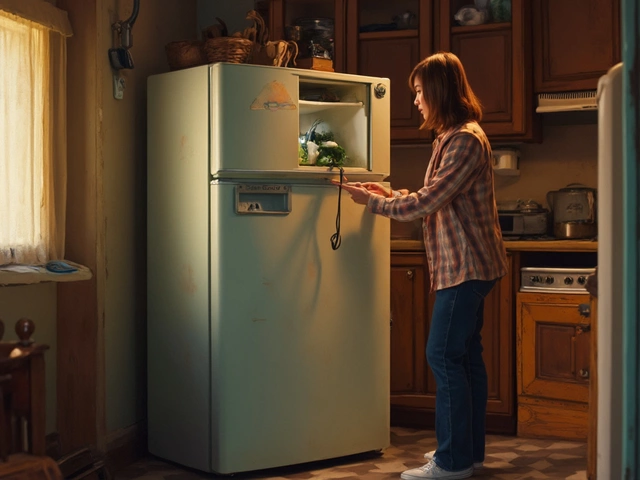Are you staring at your 7 year old fridge, wondering if it’s about to suck even more cash from your wallet? Trust me, you’re not the only one. Most fridges these days aren’t built like the tanks from decades ago, and repair bills can sting.
First thing—don’t panic. The average refrigerator is basically at halftime at seven years old. Most new models can easily push past 10, sometimes even 15 years if they’re not abused. But a breakdown at year 7 can be a red flag, or just a minor hiccup.
Before you call in a pricey repair guy, there are some simple checks you should run. Did a bunch of food block the vents and mess with airflow? Is there a thick layer of dust on the coils making it work harder? Sometimes the fix is embarrassingly easy.
If those basics look fine, grab your receipt or check the manufacture date again. If your fridge was a budget buy, repairs might not be worth it. But if it was top-of-the-line, a fix could let you squeeze out a few more years without the huge headache (and cost) of picking out a new one.
- Real Lifespan and Performance at 7 Years
- Cost Breakdown: Repairs vs. Replacement
- Common Problems Worth Fixing (and Not)
- Smart Tips to Stretch Out Your Fridge’s Life
Real Lifespan and Performance at 7 Years
The truth is, most modern refrigerators are designed to last somewhere between 10 and 15 years. At 7 years, yours sits in that awkward middle age—not exactly new, but not ancient either. Reliability at this point can depend on how often you’ve defrosted it, how full you keep it, and even what brand you bought.
Here’s a look at what the major brands actually claim and what repair pros see:
| Brand | Expected Lifespan | Common Issues by Year 7 |
|---|---|---|
| Whirlpool | 13 years | Compressor, ice maker |
| Samsung | 11-14 years | Control boards, freezer icing |
| LG | 12 years | Evaporator fan, leaks |
| GE | 12 years | Thermostat, water filter |
| Frigidaire | 9-12 years | Seals, defrost sensor |
If you’re noticing the fridge running louder, food spoiling faster, or random ice build-up, these are all signs things might be slipping. Sometimes these issues are just a warning to clean the coils or check the door seal, but if it keeps happening, it’s a hint that something bigger is going on inside. Older budget fridges sometimes show serious problems just after the 5-year mark, while the fancier models tend to hold out a bit longer.
- Ever cleaned your fridge coils? Dust buildup is a fridge killer. Those who do it once a year usually get extra mileage.
- Storing more than 70% capacity actually helps regulate temperature better. Under-filled fridges overwork.
- Power outages and lots of door-opening age a fridge faster than normal use.
If you’re searching for advice on refrigerator repair at this age, you’re right to question if it’s just a quick fix or the start of a long goodbye. Sometimes a little maintenance now saves you from a big headache later.
Cost Breakdown: Repairs vs. Replacement
The big question is always about money. Fix the old fridge, or just go get a new one? There’s more to this than just looking at the first repair estimate.
Let’s get real about the numbers. On average, a typical refrigerator repair costs anywhere from $150 to $400. The amount mostly depends on what’s broken—swapping out a thermostat is way cheaper than replacing a busted compressor. For some context, here's what you might pay for common fixes:
| Part/Repair | Typical Cost |
|---|---|
| Thermostat replacement | $100 - $250 |
| Door seal/gasket | $50 - $150 |
| Compressor repair/replacement | $500 - $700 |
| Condenser coil cleaning/service | $60 - $100 |
| Defrost heater replacement | $120 - $200 |
If you find yourself staring at a quote that’s over $400, and your fridge isn’t super fancy or less than five years old, you’re probably better off shopping for a new one. New standard fridges start around $700, but good models from brands like GE or Whirlpool are usually around $1,200.
Here's a rule of thumb repair techs use: if the repair costs more than half what a brand new fridge costs, skip the repair. Put that money toward an upgrade instead.
- If your fridge needs just a minor fix costing under $200, and everything else works fine, it’s worth doing.
- If you’re facing multiple issues or costly parts like a compressor, it doesn’t make sense long-term.
Keep in mind, an old fridge isn’t just a gamble on future repairs. Older units are less energy efficient. Replacing it with an Energy Star model can chop $30 to $50 a year off your electric bill. Long-term, that can add up fast.
Bottom line: weigh the cost of refrigerator repair against the real price of a new fridge plus any energy savings. Don’t let nostalgia or hassle talk you into sinking cash into a lost cause.

Common Problems Worth Fixing (and Not)
Let’s cut to the chase: not every fridge problem is worth the cost or hassle to fix, especially if you’ve got a 7 year old model. So what’s an easy repair, and when are you better off shopping for a new refrigerator?
Here’s a quick breakdown:
- Thermostat or temperature control issues: Usually, this is a quick (and cheap) fix. Replacing a thermostat cost around $100–$200, parts and labor included.
- Door seal/gasket problems: If your fridge won’t seal, it’s wasting cooling power. A gasket is super easy to swap—less than $80 for most models.
- Clogged or frozen defrost drain: This can be hard to spot but doesn’t require fancy parts. DIYers can fix this in under an hour, and even pros rarely charge more than $150.
But if you bump into these issues, it’s time to think twice:
- Compressor failure: This is the heart of your fridge. Replacing it can run $500–$700, and it’s often not worth it since something else could go out next.
- Coolant leaks: Once coolant’s gone, repairs usually cost a fortune and can be a guessing game, so most techs don’t recommend it unless your fridge is premium and barely used.
- Frequent cycling or electrical faults: If your fridge is flipping breakers or randomly shutting down, the underlying fixes get pricey and unpredictable.
If you’re still not sure where your problem falls, take a look at this comparison:
| Issue | Typical Repair Cost | DIY Friendly? | Worth Fixing? |
|---|---|---|---|
| Thermostat | $100–$200 | Often | Yes |
| Door Gasket | $60–$80 | Yes | Absolutely |
| Defrost Drain | $100–$150 | Yes | Usually |
| Compressor | $500–$700 | No | Seldom |
| Coolant Leak | $300–$600 | No | Rarely |
| Control Board | $250–$400 | No | Maybe |
Here’s a pro tip: If your repair bill is more than half the price of a new fridge (and your fridge is seven years old), replacement almost always wins. But if it’s a minor part or labor is cheap, a quick fix could keep your kitchen running for a couple more years.
Smart Tips to Stretch Out Your Fridge’s Life
If you want to keep your refrigerator repair bills down, a little routine care goes a long way. People are often surprised how much difference basic maintenance makes, especially as your fridge gets older.
- Vacuum those coils twice a year. Dusty coils make the compressor work much harder, which shortens its life. Most fridges have the coils either on the back or underneath. Just unplug it, pop off the cover if there is one, and use a hose attachment or a coil brush (you can grab one for a few bucks online).
- Keep the door seals clean and tight. Worn out or dirty gaskets let cold air leak, and then your fridge runs overtime. Just wipe them with a bit of soapy water and check for cracks. If a dollar bill slips out too easily when you shut the door on it, replacing the gasket is cheap and easy.
- Don’t block the vents inside. Shoving food right up against the back or sides blocks airflow, and then things don’t cool evenly. Leave a couple of inches between food and the fridge walls, especially near those little vents.
- Set it to the right temp. The sweet spot is between 37°F and 40°F (that’s 3–4°C for anyone outside the U.S.). Colder isn’t better for food or energy use. If you’ve never checked yours, a $5 fridge thermometer from the hardware store can save you headaches later.
- Defrost when needed. If you see thick ice building up in a non-frost-free model, it’s working harder than it should. Defrost as soon as you notice ice piling up, or your fridge will be fighting a losing battle.
Here’s one most people forget: Keep your fridge at least a couple of inches away from the wall. That gap helps heat escape so the compressor doesn’t cook itself over time. And if you’re headed out of town for more than a week, empty it and leave the doors slightly open—seriously, nobody wants to deal with smelly mold later.
Don’t buy into those fridge “miracle cleaner” sprays. Mild soap and water is all you need, and anything harsh can crack plastic parts or wear out seals. Just plain maintenance beats any gimmick out there.




